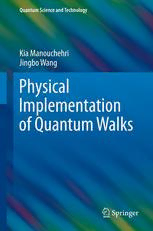Table Of ContentQuantum Science and Technology
Jingbo Wang
Kia Manouchehri
Physical
Implementation
of Quantum Walks
Quantum Science and Technology
SeriesEditors:
HuzihiroAraki,KyotoUniversity,Kyoto,Japan
MarkusArndt,UniversityofVienna,Vienna,Austria
HowardBrandt,USArmyResearchLaboratory,Adelphi,MD,USA
NicolasGisin,UniversityofGeneva,Geneva,Switzerland
RaymondLaflamme,UniversityofWaterloo,Waterloo,Canada
GabyLenhart,ETSI,Sophia-Antipolis,France
DanielLidar,UniversityofSouthernCalifornia,LosAngeles,CA,USA
GerardMilburn,UniversityofQueensland,St.Lucia,Australia
MasanoriOhya,TokyoUniversityofScience,Tokyo,Japan
ArnoRauschenbeutel,ViennaUniversityofTechnology,Vienna,Austria
RenatoRenner,ETHZurich,Zurich,Switzerland
MaximilianSchlosshauer,UniversityofPortland,Portland,OR,USA
HowardWiseman,GriffithUniversity,Brisbane,Australia
Forfurthervolumes:
http://www.springer.com/series/10039
Quantum Science and Technology
Aims and Scope
The book series Quantum Science and Technology is dedicated to one of today’s
most active and rapidly expanding fields of research and development. In par-
ticular, the series will be a showcase for the growing number of experimental
implementationsandpracticalapplicationsofquantumsystems.Thesewillinclude,
but are not restricted to: quantum information processing, quantum computing,
and quantum simulation; quantum communication and quantum cryptography;
entanglementandotherquantumresources;quantuminterfacesandhybridquantum
systems;quantummemoriesandquantumrepeaters;measurement-basedquantum
controland quantumfeedback;quantumnanomechanics,quantumoptomechanics
and quantum transducers; quantum sensing and quantum metrology; as well as
quantum effects in biology. Last but not least, the series will include books on
thetheoreticalandmathematicalquestionsrelevanttodesigningandunderstanding
these systems anddevices, aswell as foundationalissues concerningthe quantum
phenomenathemselves.Written andeditedbyleadingexperts,thetreatmentswill
be designed for graduate students and other researchers already working in, or
intendingtoenterthefieldofquantumscienceandtechnology.
Kia Manouchehri Jingbo Wang
(cid:2)
Physical Implementation
of Quantum Walks
123
KiaManouchehri
JingboWang
SchoolofPhysics
TheUniversityofWesternAustralia
Perth
Australia
ISBN978-3-642-36013-8 ISBN978-3-642-36014-5(eBook)
DOI10.1007/978-3-642-36014-5
SpringerHeidelbergNewYorkDordrechtLondon
LibraryofCongressControlNumber:2013944193
(cid:2)c Springer-VerlagBerlinHeidelberg2014
Thisworkissubjecttocopyright.AllrightsarereservedbythePublisher,whetherthewholeorpartof
thematerialisconcerned,specificallytherightsoftranslation,reprinting,reuseofillustrations,recitation,
broadcasting,reproductiononmicrofilmsorinanyotherphysicalway,andtransmissionorinformation
storageandretrieval,electronicadaptation,computersoftware,orbysimilarordissimilarmethodology
nowknownorhereafterdeveloped.Exemptedfromthislegalreservationarebriefexcerptsinconnection
with reviews or scholarly analysis or material supplied specifically for the purpose of being entered
and executed on a computer system, for exclusive use by the purchaser of the work. Duplication of
this publication or parts thereof is permitted only under the provisions of the Copyright Law of the
Publisher’slocation,initscurrentversion,andpermissionforusemustalwaysbeobtainedfromSpringer.
PermissionsforusemaybeobtainedthroughRightsLinkattheCopyrightClearanceCenter.Violations
areliabletoprosecutionundertherespectiveCopyrightLaw.
Theuseofgeneraldescriptivenames,registerednames,trademarks,servicemarks,etc.inthispublication
doesnotimply,evenintheabsenceofaspecificstatement,thatsuchnamesareexemptfromtherelevant
protectivelawsandregulationsandthereforefreeforgeneraluse.
While the advice and information in this book are believed to be true and accurate at the date of
publication,neithertheauthorsnortheeditorsnorthepublishercanacceptanylegalresponsibilityfor
anyerrorsoromissionsthatmaybemade.Thepublishermakesnowarranty,expressorimplied,with
respecttothematerialcontainedherein.
Printedonacid-freepaper
SpringerispartofSpringerScience+BusinessMedia(www.springer.com)
Preface
Random walks have been employed in virtually every science related discipline
to model everyday phenomena such as biochemical reaction pathways and DNA
synapsis(Sessionsaetal.1997),thegenomicdistancefromDNAsequencelocation
in cell nuclei (van den Engh et al. 1992), optimal search strategies for hidden
targets such as animals’ foraging (Be´nichou et al. 2005), diffusion and mobility
in materials (Trautt et al. 2006), the trail of a particle undergoing brownian
motion(Stewart2001)aswellasexchangerateforecast(KilianandTaylor2003).
Theyhavealsofoundalgorithmicapplications,forexample,insolvingdifferential
equations (Hoshino and Ichida 1971), quantum monte carlo for solving the many
bodySchro¨dingerequation(Ceperleyand Alder 1986),optimization(Berg1993),
clustering and classification (Scho¨ll and Scho¨ll-Paschingerb 2003), fractal theory
(Anteneodo and Morgado 2007) or even estimating the relative sizes of Google,
MSNandYahoosearchengines(Bar-YossefandGurevich2006).
Whilst the so called classical random walks have been successfully utilized in
suchadiverserangeofapplications,quantumrandomwalksareexpectedtoprovide
us with a new paradigm for solving many practical problems more efficiently
(Aharonov et al. 1993; Knight et al. 2003b). In fact quantum walks have already
inspired efficient algorithms with applications in connectivity and graph theory
(Kempe2003b;DouglasandWang2008),aswellasquantumsearchandelement
distinctness (Shenvi et al. 2003; Childs and Goldstone 2004b), due to their non-
intuitiveandmarkedlydifferentproperties,includingfastermixingandhittingtimes.
Andmorerecently,somequantumwalkprocessesareshowntobecapableofacting
asuniversalcomputationalprimitives(Childs2009).
The emerging prospects for a new generation of quantum algorithms inspired
byquantumwalkshavenaturallyfuelledasecondareaofresearch:developingthe
physical“hardware”thatiscapableofperformingaquantumwalkinthelaboratory.
Aswellasbeingexperimentallyviable,suchaphysicalimplementationisexpected
to provide a natural mechanism by which it can be scaled up, enabling it to deal
withmodestlylargepracticalproblems.Moreover,whilepurposebuiltsystemsfor
implementing specific quantum walk algorithms may be more straightforward to
v
vi Preface
design,whenconsideringahypotheticalproblemformulatedintermsofaparticular
typeofgraph,developingaproblem-independentimplementationschemethatisnot
limitedtospecificconnectivitycriteriaishighlydesirable.
Over the past decade there have been several proposals for implementing
quantum walks, utilizing a variety of quantum, classical and hybrid systems
including Nuclear Magnetic Resonance, cavity QED, ion traps, optical traps,
opticalnetworksand quantumdots. Of these, a vastmajorityprovideconstructive
insights into the elements of a successful physical implementation, though in
themselves are unsuitable as a practical scheme. Other proposalshave considered
the notions of feasibility, scalability and generality of application, but only to a
limited extent. Nonetheless, while building a large scale quantum walk machine
remains a considerable challenge in the foreseeable future, “proof of principle”
implementations have already been experimentally demonstrated for a number of
proposals.
We begin this book with a brief overview of quantum walk theory, including
a description of the two main classes of walks, namely,continuous-timequantum
walks and discrete-time or coined quantum walks, as well as their properties
and applications;areas which have already received substantial treatmentin other
reviews including those of Kempe (2003b), Ambainis (2003), Kendon (2007),
and Venegas-Andraca (2012). The main focus of this book however will be the
physical implementations of quantum walks examined in the subsequent chapter,
where we present a comprehensive survey of numerous implementation schemes
todate.Thetremendousdiversityofapproachesintheseproposalshasnecessitated
referencestoawidearrayofunderlyingphysicalphenomena,particularlyinrelation
to the field of quantum optics. Therefore, to assist the reader while maintaining
continuitythroughoutthebook,aconsiderablebodyofsupplementarymaterialand
backgroundtheoryhasbeenincludedintheappendices.
In carrying out the original research described in this book, we have greatly
benefitedfromvaluableandstimulatingdiscussionswithmanypioneeringtheorists
and experimentalists in this field, in particular Gerard Milburn, Jason Twamley,
Gavin Brennen, Peter Rohde, Jeremy O’Brien, Paolo Metaloni, Dieter Meschede,
Jonathan Matthews, Andreas Schreiber, Norio Konno, Etsuo Segawa, Yutaka
Shikano,ArmandoPerez,and MiklosSantha,for whichwe are trulygrateful.We
would also like to thank Zhijian Li, Michael Delanty, and Stefan Danilishin for
their careful and critical proofreading of the manuscript, although any errors or
omissions remain solely our responsibility. Special mention should be made of a
numberofstudents,mostnotablyBrendanDouglas,ScottBerry,andThomasLoke,
whocontributedtowardsouroriginalresearchworkpresentedhere.TheUniversity
of Western Australia has provided a rich intellectual environment that led to the
completionofthisbook.ThesupportandencouragementofIanMcArthurandJim
Williams atthe Schoolof Physics, aswell as AngelaLahee(the editor)andPriya
Balamurugan(theproductioneditor)ofSpringerarealsosincerelyacknowledged.
Preface vii
Lastbutcertainlynotleast,ourdeepestgratitudegoestoourfamilies.Kiathanks
hiswife,thewonderfulShameem,forherpatientandnever-endingencouragement
of his aspirations. Jingbo thanks her ever-supportive husband Jie and her two
childrenEdwardandEric,whohavebeenaconstantsourceofjoyandinspiration.
Contents
1 TheoreticalFramework..................................................... 1
1.1 Discrete-TimeQuantumWalks........................................ 1
1.2 Continuous-TimeQuantumWalks..................................... 19
1.3 WalkingCharacteristics................................................ 24
1.4 Decoherence............................................................ 26
2 PotentialApplications ....................................................... 31
2.1 ExponentiallyFasterHitting........................................... 31
2.2 QuantumWalkBasedSearch.......................................... 32
2.3 NetworkCharacterization.............................................. 33
2.4 GraphIsomorphism .................................................... 35
2.5 ModelingQuantumPhenomena....................................... 37
2.6 UniversalComputation................................................. 38
3 PhysicalImplementation.................................................... 39
3.1 LinearOptics ........................................................... 40
3.2 NuclearMagneticResonance.......................................... 78
3.3 CavityQED............................................................. 81
3.4 QuantumOptics ........................................................ 88
3.5 IonTraps................................................................ 94
3.6 NeutralAtomTraps .................................................... 101
3.7 SolidState .............................................................. 127
3.8 QuantumCircuits....................................................... 137
3.9 RecentDevelopments.................................................. 141
Abstract ........................................................................... 151
A ElectromagneticRadiation.................................................. 153
A.1 ClassicalRadiationField............................................... 153
A.2 QuantizedRadiationField ............................................. 155
A.3 CoherentVersusFockStates........................................... 158
ix

